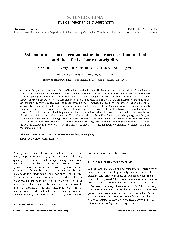摘要
Astronaut's body mass is an essential factor of health monitoring in space. The latest mass measurement device for the International Space Station (ISS) has employed a linear acceleration method. The principle of this method is that the device generates a constant pulling force, and the astronaut is accelerated on a parallelogram motion guide which rotates at a large radius to achieve a nearly linear trajectory. The acceleration is calculated by regression analysis of the displacement versus time trajectory and the body mass is calculated by using the formula m=F/a. However, in actual flight, the device is instable that the deviation between runs could be 6-7 kg. This paper considers the body non-rigidity as the major cause of error and instability and analyzes the effects of body non-rigidity from different aspects. Body non-rigidity makes the acceleration of the center of mass (C.M.) oscillate and fall behind the point where force is applied. Actual acceleration curves showed that the overall effect of body non-rigidity is an oscillation at about 7 Hz and a deviation of about 25%. To enhance body rigidity, better body restraints were introduced and a prototype based on linear acceleration method was built. Measurement experiment was carried out on ground on an air table. Three human subjects weighing 60-70 kg were measured. The average variance was 0.04 kg and the average measurement error was 0.4%. This study will provide reference for future development of China's own mass measurement device.
- 出版日期2011-4
- 单位清华大学
